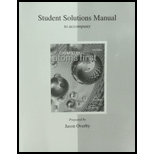
Concept explainers
Interpretation: The density of the nucleus in the atom to be calculated.
Concept Introduction:
Density: the density of the substance is calculated using the formula:
Atoms: Atoms consist of tiny particles called protons, neutrons and electrons. Proton and neutrons are present in the nucleus and the electron resides around the nucleus. The protons number will be same as the electrons count in the atom.
Nuclear stability: The nucleus is composed of protons and neutrons. The strongest nuclear force binds the particles tightly. Though the protons repel each other due to no attraction between similar charges, possess short-range attractions made the attraction possible between proton and proton, proton and neutron, neutron and neutron.
Want to see the full answer?
Check out a sample textbook solution
Chapter 2 Solutions
Student Solutions Manual For Chemistry: Atoms First
- Which of these are isotopes of hydrogen?A) 12C and 13C B) 42K and 40K C) Li+ and He D) 3H and 2H E) 2H and HeIs this correct answer D?arrow_forwardEngaging ActivitiesACTIVITY 1Directions: Identify the element described in each statement.___________1. An element with 26 protons and 30 neutrons.___________2. Has a mass number of 11 and an atomic number of 5.___________3. Has 117 neutrons and an atomic number of 78.___________4. Has 69 neutrons and 50 protons.___________5. Has 125 neutrons and an atomic number of 85.arrow_forwardObject A has a charge of 3.6 × 10 °C and object B has a charge of 4.7 × 10 °C. What is the electric force between the two objects when they are 0.7 meters away?arrow_forward
- James Bond claims he has stolen spectre’s nuclear material. It’s a black sphere with a volume of 945 cm3 and a mass of 14.3 kg. Is it the weapons-grade uranium he was hoping for?arrow_forwardDirections: Identify the isotope being described. 1. used to determine damage in heart tissue and detection of tumors.arrow_forwardConsider the element Ag (p=47, n=61) with a nuclear mass of 1.79124 x 10-22 g. (Given: mass of proton = 1.67262 x 10-24 g; mass of neutron = 1.67493 x 10-24 g) A. Calculate the total mass in grams if protons and neutrons combined to form the Ag nucleus. Total mass = x 10^ g (Express you answer in 6 sig fig, do not include the unit.) B. Calculate the mass defect in grams per mole of Ag nucleus. Mass defect = g (Express you answer in 4 sig fig, do not include the unit.) C. Calculate the binding energy in joule per mole of Ag nucleus. Binding energy =arrow_forward
- Answer the following if True or False. (1-10) 1. Radioactivity emanates from stable isotopes of certain elements. * True False 2. Electrons are neutral sub-atomic particles of the atom. * True False 3. LASER is one kind of background radiation. * True False 4. Strong nuclear force holds atoms together. * True False 5. Tremendous amount of energy is released during fission reaction. * True False 6. Radioactive decay is a spontaneous process. * True False 7. X-ray, MRI, CT scan and ultrasound are medical imaging procedures that use radiation beams. * True False 8. In the electromagnetic spectrum, the lower the frequency the higher is the energy of radiation. * True False 9. Radiation can be in the form of particle and electromagnetic waves. * True False 10. Gamma rays can be stopped by a piece of paper. * True Falsearrow_forwardA solution of selenium-75, a radioisotope used in the diagnosis of pancreatic disease, is found just prior to administration to have an activity of 44 μCi/mL. If 3.89 mL were delivered intravenously to the patient, what dose of Se-75 (in μCi) did the patient receive? Express your answer using two significant figures.arrow_forwardBoron, lithium, nitrogen, and neon each have two stable isotopes. In which of the following pairs of isotopes is the heavier isotope more abundant? Check all that apply. 20Ne or 22Ne (average mass, 20.18 u) 10B or 11B (average mass, 10.81 u) 6Li or 7Li (average mass, 6.941 u) 14N or 15N (average mass, 14.01 u)arrow_forward
 Introduction to General, Organic and BiochemistryChemistryISBN:9781285869759Author:Frederick A. Bettelheim, William H. Brown, Mary K. Campbell, Shawn O. Farrell, Omar TorresPublisher:Cengage Learning
Introduction to General, Organic and BiochemistryChemistryISBN:9781285869759Author:Frederick A. Bettelheim, William H. Brown, Mary K. Campbell, Shawn O. Farrell, Omar TorresPublisher:Cengage Learning
